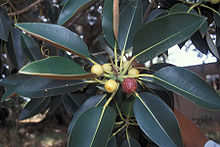| Moreton Bay fig | |
|---|---|

| |
| A specimen at The Domain, Sydney, planted in 1850 | |

| |
| Fruit and leaves, photographed on Maui, Hawaii | |
| Scientific classification | |
| Kingdom: | Plantae |
| Clade: | Tracheophytes |
| Clade: | Angiosperms |
| Clade: | Eudicots |
| Clade: | Rosids |
| Order: | Rosales |
| Family: | Moraceae |
| Genus: | Ficus |
| Subgenus: | F. subg. Urostigma |
| Species: | F. macrophylla
|
| Binomial name | |
| Ficus macrophylla | |

| |
| Natural range in Eastern Australia (in green) | |
| Synonyms | |
|
Ficus huegelii Kunth & C.D.Bouche, 1846 | |
Ficus macrophylla, commonly known as the Moreton Bay fig or Australian banyan, is a large evergreen banyan tree of the Mulberry Family (Moraceae) native to eastern Australia, from the Wide Bay–Burnett region in the north to the Illawarra in New South Wales, as well as Lord Howe Island where the subspecies F. m. columnaris is a banyan form covering 2.5 acres (a hectare) or more of ground.[2][3][4] Its common name is derived from Moreton Bay in Queensland, Australia. It is best known for its imposing buttress roots.
Ficus macrophylla is called a strangler fig because seed germination usually takes place in the canopy of a host tree, where the seedling lives as an epiphyte until its roots establish contact with the ground, when it enlarges and strangles its host, eventually becoming a freestanding tree by itself. Individuals may reach 60 m (200 ft) in height, with crown spreads as great as 250 feet (76 metres) being reported. Like all figs, it has an obligate mutualism with fig wasps; figs are pollinated only by fig wasps, and fig wasps can reproduce only in fig flowers. The wasp partner of the Moreton Bay Fig is Pleistodontes froggattii. Many species of birds, including pigeons, parrots, and various passerines, eat the fruit.
Ficus macrophylla is widely used as a feature tree in public parks and gardens in warmer climates such as California, Spain, Portugal, Italy, Malta, northern New Zealand (Auckland), and Australia. Old specimens can reach tremendous size, and their aggressive root system renders them unsuitable for all but the largest private gardens.
- ^ Cite error: The named reference
fici96was invoked but never defined (see the help page). - ^ Australian Encyclopedia, (1958 edition) Volume 5 page 369
- ^ Nicholson, Nan and Huge (1991). Australian Rainforest Plants III. The Channon, N.S.W.: <published privately>. p. 29.
- ^ The New Practical Reference Library. article "Banyan" ( Kansas City, Mo: Roach-Fowler Publishing Company, 1912) page <unpaginated>